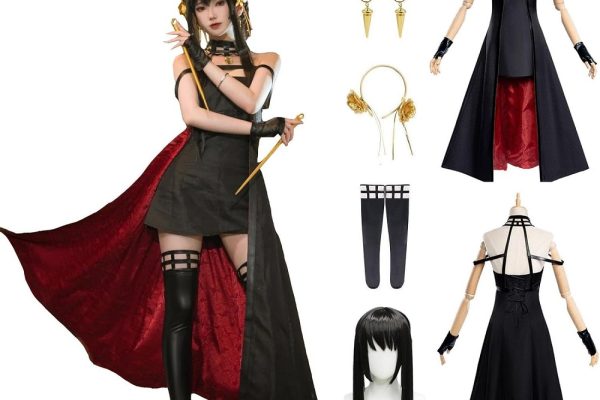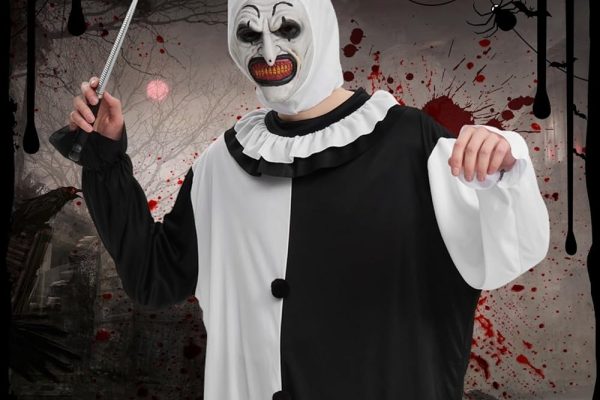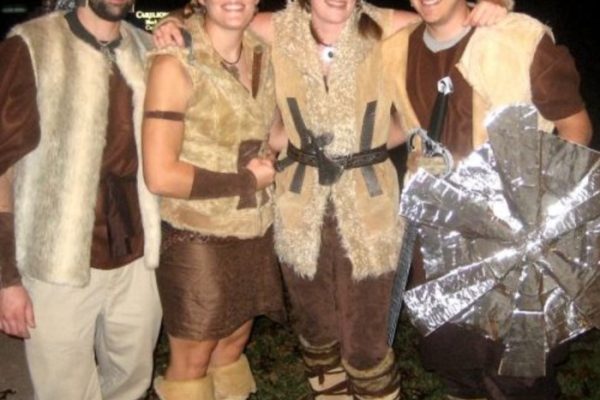The Inspiration Behind Scary Wolf Costumes
The allure of a scary wolf costume stems from its deep-rooted symbolism in folklore and horror genres. Wolves are often portrayed as powerful and mysterious creatures, embodying wilderness and fear. This image provides a thrilling basis for Halloween costumes, theatrical productions, and theme parties.

Wolf costumes tap into the universal themes of transformation and the unknown. Werewolf legends, for example, speak of humans transforming under the full moon, a concept that adds a layer of excitement and unpredictability to the costume. This metamorphosis from human to beast captures the imaginations of many, making wolf costumes a popular choice for those looking to embody an alter ego.
Moreover, movies and literature have continuously fed the popularity of the scary wolf archetype. Classics like ‘The Werewolf’ by Clemence Housman and films such as ‘An American Werewolf in London’ have cemented the wolf’s role in the domain of the eerie and supernatural. The visual and narrative impact of such works inspire enthusiasts to recreate that same ominous allure in their costumes.
In summary, scary wolf costumes draw on a rich tapestry of cultural and mythical references, making them not only popular but a profound way to explore the darker, thrilling side of nature and mythology.
Essential Materials for Your Wolf Costume
To bring your scary wolf costume to life, you’ll need a variety of materials that ensure both quality and comfort. Here’s a list of essential materials that you should consider:
- Faux Fur Fabric: Choose high-quality faux fur that mimics the texture and color variations of a real wolf’s coat. This adds authenticity to your costume.
- Flexible Foam: This material is crucial for constructing the base of the wolf’s head. It is lightweight and easy to shape.
- Mesh Fabric: For the eyes of the costume, mesh fabric allows you to see out while staying concealed.
- Acrylic Paints: These are used for adding finer details and shading to your costume, enhancing its realistic appearance.
- Elastic Bands & Velcro: Useful for securing parts of the costume to your body comfortably.
- Sewing Supplies: Heavy-duty thread, needles, and a sewing machine are essential for assembling your costume.
Selecting these materials carefully will set the foundation for a truly frightening and realistic scary wolf costume. Ensure that all materials are safe and suitable for extended wear, especially if you plan to attend events or participate in contests.
Step-by-Step Guide to Creating the Wolf’s Head
Creating a compelling wolf’s head for your scary wolf costume involves several detailed steps. This guide will walk you through each one, ensuring you can craft a headpiece that’s both realistic and menacing.
- Creating a Base: Start by using flexible foam to shape the head. You can carve the foam into the rough shape of a wolf’s skull, paying special attention to prominent features like the snout, cheekbones, and ears.
- Adding Details: Once the base is ready, use more foam to define the finer features such as the nose, lips, and the ridge above the eyes. This is where your wolf starts to come to life.
- Covering with Fur: Cover the foam base with your chosen faux fur fabric. Trim the fur to match the natural fur patterns of a wolf, with shorter fur on the face and longer fur on the neck area.
- Eyes and Teeth: Use the mesh fabric for the eyes, which allows you visibility without compromising the costume’s realism. For teeth, you can use sculpted plastics or even repurpose some sturdy white materials.
- Painting Details: Utilize acrylic paints to add shading and details around the eyes, snout, and ears to give more depth and realism to your scary wolf head.
Following these steps, you’ll have a realistic, attention-grabbing wolf’s head ready for any costume event.
Crafting the Wolf’s Body: Techniques and Tips
Crafting the body of your scary wolf costume requires a blend of creativity and attention to detail. Begin with a well-fitted base like a bodysuit, which you can then layer with faux fur fabric. Here are some techniques and tips to achieve an authentic look:
- Body Suit Base: Start with a tight-fitting, flexible body suit in a color that matches your fur. This acts as your ‘second skin’ and ensures a snug fit.
- Layering Fur: Cut the faux fur into different lengths to mimic the natural layering of a wolf’s coat. Pay particular attention to the direction of the fur.
- Securing Fur: Attach the fur pieces to the bodysuit using strong fabric glue or hand-stitching for durability.
- Muscle Definition: To emulate a wolf’s muscular build, use foam padding. Attach these pads to areas like the shoulders and thighs before covering them with fur.
- Movement Folds: Consider the movement of your body. Add extra fur at joints like elbows and knees for a natural look when moving.
- Tail Construction: Create the tail with wire inside, so it maintains shape but is adjustable. Cover this in fur as well.
By following these tips, your scary wolf costume will not only look realistic but will allow for freedom of movement, enhancing the overall effect. Remember, the key is in the details, so take your time to ensure every part looks as close to a real wolf as possible.

Adding the Finishing Touches: Fur and Textures
Adding the finishing touches to your scary wolf costume involves detailed work on fur and textures. This step transforms your costume from a basic wolf outfit to an eerily realistic representation. Here are some must-know tips to master the textures and finalize your costume:
- Variety of Fur Lengths: Use different fur lengths for diverse areas of the costume. Longer fur works well on the tail and back, while shorter fur suits the face and limbs. This variation mimics a real wolf’s coat.
- Fur Direction: Pay careful attention to the direction in which the fur lays. Generally, fur flows from the front to the back. Aligning your faux fur accordingly enhances the natural look.
- Blending Colors: To give more depth to your costume, blend different shades of fur. Most wolves have a mix of grey, white, and black. Use these colors to your advantage to create a dynamic appearance.
- Adding Textures: Besides fur, adding smaller details can make a significant impact. Consider using materials like leather for the nose and felt for small touches around the eyes and ears.
- Final Trims: After attaching all the fur, trim any uneven areas or excessively long patches. This grooming will ensure your scary wolf costume looks tidy and intentional.
With these steps, your costume will look stunningly authentic and ready for any event. The texture work, especially, will make your scary wolf costume stand out in a crowd.
Creating Realistic Wolf Movements with Your Costume
To truly embody the spirit of a wolf, your movements are a key element. Here’s how you can add lifelike motion to your scary wolf costume:
- Study Wolf Behavior: Before you suit up, watch videos of wolves. Notice how they move, rest and interact.
- Practice on All Fours: Wolves walk on their toes. Try moving around on hands and knees to mimic this.
- Use Your Head: Emulate a wolf by moving your headpiece in sharp, abrupt motions for an animalistic effect.
- Growling and Howling: Practice wolf sounds. Growl from your throat and howl rising in pitch for authenticity.
- Be Unpredictable: Add sudden starts and stops to your movements. This unpredictability is very wolf-like.
- Work on Your Stance: Stand with a slight hunch and keep your limbs loose. It gives the appearance of readiness.
- Perfect the Stalk: Walk slowly and deliberately on the balls of your feet as if stalking prey.
These techniques help create an immersive and believable scary wolf costume experience. Both your costume and your movements should work together to bring the wolf to life.
Safety Measures and Comfort Tips for Wearing Your Wolf Costume
Wearing a costume, especially something as elaborate as a scary wolf costume, requires thought for safety and comfort. To help maintain these aspects, here are several guidelines you should follow:
- Breathability: Make sure your headpiece has adequate ventilation. It’s essential for preventing overheating and allows for easy breathing.
- Visibility: Check that the eye mesh provides clear sight lines. Good vision prevents accidents and disorientation.
- Ease of Motion: Your costume should not restrict movement. Always test the range of motion in your arms, legs, and head before wearing the costume extensively.
- Comfortable Fit: Choose an underlayer that wicks away moisture and keeps you dry. Comfort extends the time you can realistically wear the costume.
- Quick Release: In case of emergency, ensure you can remove the costume swiftly. Velcro and quick-release fasteners are practical for this purpose.
- Hydration: Have a plan for staying hydrated, such as designing your costume to hold a water bladder, or scheduling regular hydration breaks.
- Allergy Test: If you’re using makeup or adhesives, do a patch test first. Avoid allergic reactions that can ruin your experience.
- Footwear: Have sturdy footwear that’s integrated into your costume. You’ll be more stable on your feet and avoid tripping.
- Trial Runs: Do a full dress rehearsal to iron out any issues before the big event. It’s the best time to make any necessary adjustments.
By incorporating these safety measures and comfort tips into your scary wolf costume, you’ll ensure not just a stunning appearance, but a secure and enjoyable experience as well.

Where to Showcase Your Scary Wolf Costume: Events and Contests
Once you have crafted your scary wolf costume, showcasing it effectively is the next exciting step. There are numerous events and contests specifically designed for costume enthusiasts where your realistic scary wolf costume will not only be admired but could also win you accolades.
- Halloween Parties: These provide a perfect backdrop for your scary wolf costume. Thrill friends and family with your creation.
- Horror Conventions: Events like horror film festivals or conventions often have costume contests. These are ideal for showcasing and even competing with your detailed wolf outfit.
- Theatrical Productions: Local theater groups may appreciate the use of your costume in a play or performance, giving it a functional purpose beyond personal enjoyment.
- Themed Photography Shoots: Collaborate with photographers to create stunning visuals for portfolios that capture the essence of your costume’s realism.
- Costume Parades: Many communities hold parades where individuals can display their creative endeavors. You’ll be a centerpiece with your wolf attire.
- Cosplay Events: If you’re into the cosplay scene, conventions provide a stage to embody the character and impress fellow enthusiasts.
Participating in these events not only allows you to showcase your scary wolf costume but also connects you with a community that shares your passion for costume creation and theatricality.





